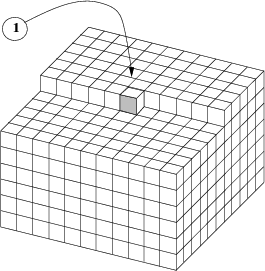Next: Blind deconvolution and the
Up: KOLMOGOROFF SPECTRAL FACTORIZATION
Previous: Causality in two dimensions
The top plane in Figure 8
is the 2-D filter seen in equation (9).
Geometrically, the 3-dimensional generalization of a helix,
Figure 8 shows a causal filter in three dimensions.
Think of the little cubes as packed with the string of the causal 1-D function.
Under the ``1'' is packed with string, but none above it.
Behind the ``1'' is packed with string, but none in front of it.
The top plane can be visualized as the area around the end of the 1-D string.
Above the top plane are zero-valued anticausal filter coefficients.
This 3-D cube is like the usual Fortran packing of a 3-D array
with one confusing difference. The starting location where the ``1''
is located is not at the Fortran (1,1,1) location.
Details of indexing are essential,
but complicated, and found near the end of this chapter.
3dpef
Figure 8.
A 3-D causal filter at the starting end of a 3-D helix.
|

|
![[pdf]](icons/pdf.png) ![[png]](icons/viewmag.png) ![[xfig]](icons/xfig.png)
|
|---|
The ``1'' that defines the end of the 1-dimensional filter
becomes in 3-D a point of central symmetry.
Every point inside a 3-D filter has a mate opposite the ``1'' that is outside the filter.
Altogether they fill the whole space leaving no holes.
From this you may deduce that the ``1'' must lie
on the side of a face
as shown in Figure 8.
It cannot lie on the corner of a cube.
It cannot be at the Fortran of f(1,1,1).
If it were there, the filter points inside
with their mirror points outside would not full the entire space.
It could not represent all possible 3-D autocorrelation functions.
Next: Blind deconvolution and the
Up: KOLMOGOROFF SPECTRAL FACTORIZATION
Previous: Causality in two dimensions
2015-03-25
